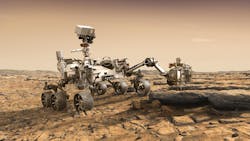The next iteration of the Mars rover has similar design features to the Curiosity rover currently exploring Mars, however it is more technologically advanced than its predecessor. The new rover will have seven new instruments, redesigned wheels, and be more autonomous. However, the standout feature of the new Mars 2020 rover is the Mars helicopter—the first of its kind. It is small, autonomous, and will help demonstrate the viability and potential of heavier-than-air vehicles on different planets.
The Mars helicopter design started in 2013 and took more than four years to achieve a lightweight and durable solution. The aircraft weighs less than four pounds and its fuselage is the size of a softball. It has twin counter-rotating blades and will rotate at 3,000 revolutions per minute (rpm), about 10 times the rate of a helicopter on Earth. The helicopter contains its own instrumentation to explore Mars, including solar cells to charge is lithium-ion batteries and a heating mechanism to warm it in low-temperature situations. The helicopter will be launched once the rover reaches a suitable location and its batteries are fully charged. The hope is that the helicopter will be lead to future low-flying scouts. Currently, the helicopter has a flying power of 220 W, and can make short vertical climbs of up to 10 ft and hover for about 30 sec.
“The atmosphere of Mars is only 1% that of Earth, so when our helicopter is on the Martian surface, it’s already at the Earth equivalent of 100,000 feet up,” said Mimi Aung, Mars Helicopter project manager at JPL. “To make it fly at that low atmospheric density, we had to scrutinize everything, [making] it as light as possible while being as strong and as powerful as it can possibly be.
“We don’t have a pilot and Earth will be several light minutes away, so there is no way to joystick this mission in real time,” Aung continued. “Instead, we have an autonomous capability that will be able to receive and interpret commands from the ground, and then fly the mission on its own.”
Along with the helicopter, the Mars 2020 rover will be equipped with a new drill that will capture rock cores, and at the same time a mini-robotic arm will seal up the samples for future pickup. Other tool advances will include an X-ray spectrometer that targets spots on a microscale, an ultraviolet laser to detect energy from excited rings of carbon atoms, a ground-penetrating radar to investigate under the surface of Mars, color cameras, enhanced zoom capabilities, and a laser to vaporize rocks and soils for chemical analysis. The enhanced radar for underground inspection is the first of its kind that will provide insight into the layers of rock, water, and ice up to 30 ft for mapping purposes.Mars
The new Mars 2020 rover program is under the direction of the Jet Propulsion Laboratory (JPL). It oversees not just the rover but also the mission’s cruise stage (which will fly the rover through space) and the descent stage (a rocket-powered crane that will lower the rover to the planet’s surface). The Mars 2020 rover overall design relies heavily on the Curiosity rover. 85% of the new rover’s mass is based on the Curiosity’s design. “The fact that so much of the hardware has already been designed—or even already exists—is a major advantage for this mission,” said Jim Watzin, director of NASA's Mars Exploration Program. “It saves us money, time and, most of all, reduces risk.”
The main mission of the Mars 2020 rover is to investigate the ancient life that once existed on Mars, such as historic lakes and rivers.
The main mission of the new rover will to seek signs of ancient life by studying the Mars terrain, which once held rivers and lakes 3.5 billion years ago. “Our next instruments will build on the success of [Curiosity], which was a proving ground for new technology,” said George Tahu, NASA’s Mars 2020 program executive. “These will gather science data in ways that weren’t possible before.” The new mission is to collect at least 20 to 40 rock core samples.
Mars 2020 rover will launch on a United Launch Alliance (ULA) Atlas V rocket from Space Launch Complex 41 at Cape Canaveral Air Force Station in Florida, and is expected to reach Mars in February 2021.
















